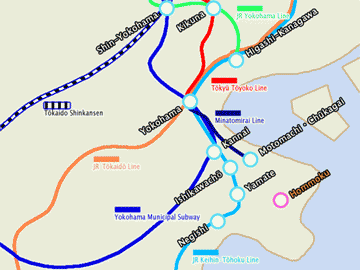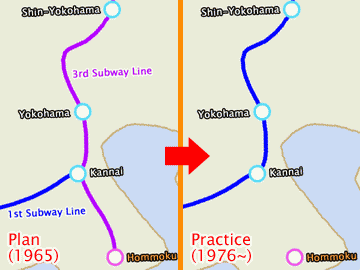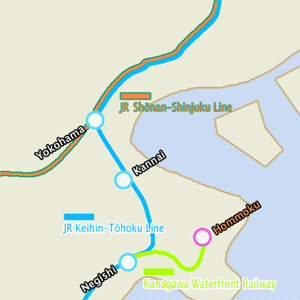Solitary island of the ground: Hommoku
 Hommoku is about six kilometers south-east from Yokohama
and close to Chinatown and Yokohama Bay Bridge. It is a residential area, and it was recently redeveloped with some shopping and leisure institutions.
However, the main transport is not the train, but still cars and buses. There is no railway in the central Hommoku. Walking to JR Yamate station, the nearest station at which the JR Negishi (Keihin-Tōhoku) line stops,
takes over 30 minutes (2.5 kilometers). Instead it is convenient to go to Ishikawachō station by bus (4.7 kilometers) because there is no bus going to Yamate station; it takes about 20 minutes.
Since people have lived there for a long time, some railways must be constructed.
Hommoku is about six kilometers south-east from Yokohama
and close to Chinatown and Yokohama Bay Bridge. It is a residential area, and it was recently redeveloped with some shopping and leisure institutions.
However, the main transport is not the train, but still cars and buses. There is no railway in the central Hommoku. Walking to JR Yamate station, the nearest station at which the JR Negishi (Keihin-Tōhoku) line stops,
takes over 30 minutes (2.5 kilometers). Instead it is convenient to go to Ishikawachō station by bus (4.7 kilometers) because there is no bus going to Yamate station; it takes about 20 minutes.
Since people have lived there for a long time, some railways must be constructed.
 In fact, the Yokohama Municipal Subway was once planned to come to Hommoku.
According to Yokohama-shi Kōsoku Tetsudō Kensetsu-shi (1987), in 1965, its 3rd subway line was planned to run from north-west Shin-Yokohama (called Kōhoku New Town) to Hommoku via Yokohama. At the same time the plan of its 1st subway line was changed
to run a through service with the 3rd subway line. Both lines would be connected at Kannai station, which was on the planned 3rd subway line, so it was decided that the 3rd subway line would not to come to Hommoku.
These subways launched in 1976, and Hommoku went through the first disappointment.
In fact, the Yokohama Municipal Subway was once planned to come to Hommoku.
According to Yokohama-shi Kōsoku Tetsudō Kensetsu-shi (1987), in 1965, its 3rd subway line was planned to run from north-west Shin-Yokohama (called Kōhoku New Town) to Hommoku via Yokohama. At the same time the plan of its 1st subway line was changed
to run a through service with the 3rd subway line. Both lines would be connected at Kannai station, which was on the planned 3rd subway line, so it was decided that the 3rd subway line would not to come to Hommoku.
These subways launched in 1976, and Hommoku went through the first disappointment.
 In 1985, the Ministry of Transport (now called MLIT, the Ministry of Land, Infrastructure and Transport) formulated a concrete plan
to construct a railway which would run along Negishi, Hommoku, Motomachi, Minatomirai area, and Higashi-Kanagawa, the terminal of the JR Yokohama line (MLIT 2001),
but Japan National Railway (now JR) gave up its plan of constructing that railway because of the financial difficulties.
In 1987, Yokohama City planned the Minatomirai21 line (the name of presence Minatomirai line), which would be connected with the Tōkyū Tōyoko line at Yokohama station.
Hommoku started its redevelopment in the expectation of the expected Hommoku station of the Minatomirai line. A friend who lives next to Hommoku said that people had believed
that the Minatomirai line would come. However, in 1989, Yokohama Minatomirai Railway Company applied to construct the railway between Yokohama and Motomachi.
In 1985, the Ministry of Transport (now called MLIT, the Ministry of Land, Infrastructure and Transport) formulated a concrete plan
to construct a railway which would run along Negishi, Hommoku, Motomachi, Minatomirai area, and Higashi-Kanagawa, the terminal of the JR Yokohama line (MLIT 2001),
but Japan National Railway (now JR) gave up its plan of constructing that railway because of the financial difficulties.
In 1987, Yokohama City planned the Minatomirai21 line (the name of presence Minatomirai line), which would be connected with the Tōkyū Tōyoko line at Yokohama station.
Hommoku started its redevelopment in the expectation of the expected Hommoku station of the Minatomirai line. A friend who lives next to Hommoku said that people had believed
that the Minatomirai line would come. However, in 1989, Yokohama Minatomirai Railway Company applied to construct the railway between Yokohama and Motomachi.
On the first day of February, 2004, the Minatomirai line terminated at Motomachi-Chūkagai, which is short of Hommoku.
The necessity for Hommoku station
The Minatomirai line must extend to Hommoku and open Hommoku station immediately. The Minatomirai line runs a through service with the Tōyoko line, which runs between Yokohama and Shibuya.
And this through service is planned to run to Shinjuku and Ikebukuro, in the west and north downtown Tōkyō. On the other hand, the Kanagawa Waterfront Railway is also near Hommoku.
This railway company doesn't carry passengers, but carries freight and cargo from Yokohama Port. And it is an affiliated company of JR Freight, which often lends its railway to JR East.
JR East Railway Company runs the Shōnan-Shinjuku line, which is the rival in the Tōyoko line. To increase the number of users of the Shōnan-Shinjuku line, JR East may use the railway
owned by Kanagawa Waterfront Railway from JR Freight and start to carry passengers from Hommoku to JR Negishi station.
| Ways |
Time |
Fare |
Transfer(s) |
| Conventional route*1 |
65 |
750 |
Yokohama |
| Conventional route*2 |
60 |
830 |
Negishi, Yokohama |
| Minatomirai line |
48 |
620 |
(None) |
| Kanagawa W. Railway |
55 |
690 |
Negishi |
Consider that passengers have to get to Shinjuku station by 8:30 a.m., and comparing with which transport they use the first.
The Minatomirai line is considered to run a through service with Tōyoko line and the Tokyo Metro 13th subway line from Hommoku station.
Otherwise, consider that passengers take the Shōnan-Shinjuku line after arriving at Yokohama station by bus or the JR Negishi (Keihin-Tōhoku) line.
Conventional route *1 is that passengers first take the bus from Hommoku to Yokohama station (¥210), and change to the JR Shōnan-Shinjuku line to Shinjuku (¥540).
Conventional route *2 is that passengers first take the bus from Hommoku to Negishi station (¥210), and change to the JR Keihin-Tōhoku line to Yokohama,
then change to the JR Shōnan-Shinjuku line to Shinjuku (JR total: ¥620).
"Kanagawa W. Railway" means that passengers first take thr Kanagawa Waterfront Railway from Yokohama-Hommoku station (its station that already stands near Hommoku) to Negishi station,
and change to the JR Keihin-Tōhoku line to Yokohama, then change the JR Shōnan-Shinjuku line to Shinjuku (JR total: ¥690). Consider that Kanagawa Waterfront Railway starts to carry passengers.

 If the Minatomirai line comes to Hommoku, we can expect that people will be able to get to Shinjuku 17 minutes faster and ¥130 cheaper than now.
Consider that passengers have to get to Shinjuku station by 8:30 a.m. on weekday using two kinds of conventional ways and two considering ways.
If the Minatomirai line comes to Hommoku, we can expect that people will be able to get to Shinjuku 17 minutes faster and ¥130 cheaper than now.
Consider that passengers have to get to Shinjuku station by 8:30 a.m. on weekday using two kinds of conventional ways and two considering ways.
And moreover, the railway has three advantages over the bus:
- A capacity in one service
- Services in an hour
- The last service of the day is late
For these reasons, Hommoku station of the Minatomirai line should be popular among people living near there.
The profits of both the Minatomirai line and the Tōyoko line
It should be also profitable for both railway companies if Hommoku station opens. The total of the passengers using the Minatomirai line is not much on weekdays
because this line runs through the tourist spots and there are not so residential areas. If commuters and students use the Minatomirai line, it can also yield profits on weekdays.
And traveling via the Tōyoko line, they also pay its fare. In addition, there is a possibility that people living in Hommoku tend to use not the JR lines from Yamate and Negishi station,
but the Tōyoko line to go somewhere other than Shinjuku.
Works cited:
MLIT (2001) "Kōsoku tetsudō nadono seibi keikaku" (The plan for constructing railways)
in the transport council's seventh report (1985).
Yokohama Municipal Transport Bureau (1987) Yokohama-shi Kōsoku Tetsudō Kensetsu-shi ("The history of the construction of high-speed railways in Yokohama city"). Tokyo: DNP.
[TOP]
[Intro] [Boarding] [Smoking] [Priority] [Phones]
[Vacant] [Comfort] [13th] [Shinjuku] [Hommoku]
Soliloquy of my Railway © Satoshi Oshio, 2005


 Hommoku is about six kilometers south-east from Yokohama
and close to Chinatown and Yokohama Bay Bridge. It is a residential area, and it was recently redeveloped with some shopping and leisure institutions.
However, the main transport is not the train, but still cars and buses. There is no railway in the central Hommoku. Walking to JR Yamate station, the nearest station at which the JR Negishi (Keihin-Tōhoku) line stops,
takes over 30 minutes (2.5 kilometers). Instead it is convenient to go to Ishikawachō station by bus (4.7 kilometers) because there is no bus going to Yamate station; it takes about 20 minutes.
Since people have lived there for a long time, some railways must be constructed.
Hommoku is about six kilometers south-east from Yokohama
and close to Chinatown and Yokohama Bay Bridge. It is a residential area, and it was recently redeveloped with some shopping and leisure institutions.
However, the main transport is not the train, but still cars and buses. There is no railway in the central Hommoku. Walking to JR Yamate station, the nearest station at which the JR Negishi (Keihin-Tōhoku) line stops,
takes over 30 minutes (2.5 kilometers). Instead it is convenient to go to Ishikawachō station by bus (4.7 kilometers) because there is no bus going to Yamate station; it takes about 20 minutes.
Since people have lived there for a long time, some railways must be constructed. In fact, the Yokohama Municipal Subway was once planned to come to Hommoku.
According to Yokohama-shi Kōsoku Tetsudō Kensetsu-shi (1987), in 1965, its 3rd subway line was planned to run from north-west Shin-Yokohama (called Kōhoku New Town) to Hommoku via Yokohama. At the same time the plan of its 1st subway line was changed
to run a through service with the 3rd subway line. Both lines would be connected at Kannai station, which was on the planned 3rd subway line, so it was decided that the 3rd subway line would not to come to Hommoku.
These subways launched in 1976, and Hommoku went through the first disappointment.
In fact, the Yokohama Municipal Subway was once planned to come to Hommoku.
According to Yokohama-shi Kōsoku Tetsudō Kensetsu-shi (1987), in 1965, its 3rd subway line was planned to run from north-west Shin-Yokohama (called Kōhoku New Town) to Hommoku via Yokohama. At the same time the plan of its 1st subway line was changed
to run a through service with the 3rd subway line. Both lines would be connected at Kannai station, which was on the planned 3rd subway line, so it was decided that the 3rd subway line would not to come to Hommoku.
These subways launched in 1976, and Hommoku went through the first disappointment. In 1985, the Ministry of Transport (now called MLIT, the Ministry of Land, Infrastructure and Transport) formulated a concrete plan
to construct a railway which would run along Negishi, Hommoku, Motomachi, Minatomirai area, and Higashi-Kanagawa, the terminal of the JR Yokohama line (MLIT 2001),
but Japan National Railway (now JR) gave up its plan of constructing that railway because of the financial difficulties.
In 1987, Yokohama City planned the Minatomirai21 line (the name of presence Minatomirai line), which would be connected with the Tōkyū Tōyoko line at Yokohama station.
Hommoku started its redevelopment in the expectation of the expected Hommoku station of the Minatomirai line. A friend who lives next to Hommoku said that people had believed
that the Minatomirai line would come. However, in 1989, Yokohama Minatomirai Railway Company applied to construct the railway between Yokohama and Motomachi.
In 1985, the Ministry of Transport (now called MLIT, the Ministry of Land, Infrastructure and Transport) formulated a concrete plan
to construct a railway which would run along Negishi, Hommoku, Motomachi, Minatomirai area, and Higashi-Kanagawa, the terminal of the JR Yokohama line (MLIT 2001),
but Japan National Railway (now JR) gave up its plan of constructing that railway because of the financial difficulties.
In 1987, Yokohama City planned the Minatomirai21 line (the name of presence Minatomirai line), which would be connected with the Tōkyū Tōyoko line at Yokohama station.
Hommoku started its redevelopment in the expectation of the expected Hommoku station of the Minatomirai line. A friend who lives next to Hommoku said that people had believed
that the Minatomirai line would come. However, in 1989, Yokohama Minatomirai Railway Company applied to construct the railway between Yokohama and Motomachi.
 If the Minatomirai line comes to Hommoku, we can expect that people will be able to get to Shinjuku 17 minutes faster and ¥130 cheaper than now.
Consider that passengers have to get to Shinjuku station by 8:30 a.m. on weekday using two kinds of conventional ways and two considering ways.
If the Minatomirai line comes to Hommoku, we can expect that people will be able to get to Shinjuku 17 minutes faster and ¥130 cheaper than now.
Consider that passengers have to get to Shinjuku station by 8:30 a.m. on weekday using two kinds of conventional ways and two considering ways.